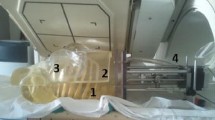Abstract
Background
Ongoing advancements in SPECT-CT technology raise important questions regarding the differences in performance between various cameras and their respective image-processing algorithms. Our study seeks the answer to this question via measurement of phantom myocardial wall thickness (MWT) on images obtained from three state-of-the-art cameras.
Methods
A thorax phantom with an insert modeling a healthy heart was scanned using cardiac acquisition protocols with Philips’ Precedence (PP), GE’s Infinia Hawkeye (IH), and Siemens’ Symbia-T6 (SS). Processing was performed using advanced reconstruction techniques available on the cameras and our own independent software. The MWT measurement was used as a figure of merit in performance evaluation.
Results
When using 50% threshold, MWTs measured for the data acquired using PP, IH, and SS and reconstructed with independent standardized software were 8.5 ± 1.2 mm, 7.7 ± 1.2 mm, and 9.3 ± 0.9 mm, respectively; and 9.3 ± 0.5 mm, 19.2 ± 0.8 mm and 18.4 ± 1.1 mm when using the manufacturers’ own reconstructions, respectively. Thresholds optimized for each image (ranging from 32% to 68%) produced much more uniform results.
Conclusions
No significant differences were observed between image resolutions when data acquired from different cameras were reconstructed with an independent algorithm. However, different manufacturers’ reconstruction algorithms produced MWTs that differed by up to about 110% when using a set threshold of 50%.











Similar content being viewed by others
References
Ficaro EP, Fessler JA, Shreve PD, et al. Simultaneous transmission/emission myocardial perfusion tomography: Diagnostic accuracy of attenuation-corrected 99mTc-sestamibi single-photon emission computed tomography. Circulation 1996;93:463-73.
Heller GV, Bateman TM, Johnson LL, et al. Clinical value of attenuation correction in stress-only Tc-99m sestamibi SPECT imaging. J Nucl Cardiol 2004;11:273-81.
Myers RW, Haseman MK, Durbin M, et al. Halftime acquisition of MPI with maintained image quality. J Nucl Cardiol 2006;13:S14-5.
Frey EC, Gilland KL, Tsui BM. Application of task-based measures of image quality to optimization and evaluation of three-dimensional reconstruction-based compensation methods in myocardial perfusion SPECT. IEEE Trans Med Imaging 2002;21:1040-50.
Vija H, Hawman EG, Engdahl JC. Analysis of a SPECT OSEM reconstruction method with 3D beam modeling and optional attenuation correction: Phantom studies. In: 2003 IEEE nuclear science symposium, Medical imaging conference, 2003, Oct 19-26, Portland, USA, p. 2662-6.
Borges-Neto S, Pagnanelli R, Shaw K, et al. Clinical validation of a novel wide beam reconstruction method for shortening scan time of gated cardiac SPECT perfusion studies. J Nucl Cardiol 2007;14:555-65.
Blinder S, Celler A, Wells RG, et al. Experimental verification of 3D detector response compensation using the OSEM reconstruction method. In: 2001 IEEE nuclear science symposium conference record, 2001, San Diego, USA, p. 2174-8.
Floyd CE, Jaszczak RJ, Harris CC, et al. Energy and spatial distribution of multiple order Compton scattering in SPECT: A Monte Carlo investigation. Phys Med Biol 1984;29:1217-30.
Frey EC, Tsui MW. A new method for modeling the spatially-variant, object-dependent scatter response function in SPECT. In: Proceeding of 1995 nuclear science symposium, 1996, p. 1082-6.
Beekman FJ, Kamphuis C, Frey EC. Scatter compensation methods in 3D iterative SPECT reconstruction: A simulation study. Phys Med Biol 1997;42:1619-32.
Wells RG, Celler A, Harrop R. Analytical calculation of photon distributions of SPECT projections. IEEE Trans Nucl Sci 1998;45:3202-14.
Vandervoort E, Celler A, Wells G, et al. Implementation of an analytically based scatter correction in SPECT reconstructions. In: IEEE nuclear science symposium conference record, 2003, Oct 19-25, p. 2647-51.
O’Connor MK, Kemp B, Anstett F, et al. A multicenter evaluation of commercial attenuation compensation techniques in cardiac SPECT using phantom models. J Nucl Cardiol 2002;9:361-76.
Shcherbinin S, Celler A, Belhocine T, et al. Accuracy of quantitative reconstructions in SPECT/CT imaging. Phys Med Biol 2008;53:4595-604.
Knoll P, Kotalova D, Zadrazil L, et al. Evaluation of advanced SPECT reconstruction technologies. Eur J Nucl Med Imaging 2008;35:S154-80.
National Electrical Manufacturers Association. NEMA standards publication NU 1-2007. Performance measurements of gamma cameras.
Ye J, Song X, Zhao Z, et al. Iterative SPECT reconstruction using matched filtering for improved image quality. In: IEEE nuclear science symposium conference record, 2006, Oct 29-Nov 1, p. 2285-7.
Rova A, Celler A, Hamarneh G. NMQC: A NEMA-compliant software application for gamma camera quality control. J Digital Imaging 2007. doi:10.1007/s10278-007-9030-y.
Dixon KL, Baldwin LN, Coquinco B, et al. A robust and versatile method for the quantification of myocardial perfusion defect size. In: IEEE nuclear science symposium and medical imaging conference record, 2003, Oct 19-23, Portland, USA, p. 2707-11.
Germano G, Kavanagh PB, Waechter P, et al. A new algorithm for the quantitation of myocardial perfusion SPECT. I: Technical principles and reproducibility. J Nucl Med 2000;41:712-9.
O’Connor M, Hammell T, Gibbons R. In vitro validation of a simple tomographic technique for estimation of percentage myocardium at risk using methoxyisobutyl isonitrile technetium 99m (sestamibi). Eur J Nucl Med 1990;17:69-76.
Wu M, Gao G, Sievers R, et al. Pinhole single-photon emission computed tomography for myocardial perfusion imaging of mice. J Am Coll Cardiol 2003;42:576-82.
Author information
Authors and Affiliations
Corresponding author
Rights and permissions
About this article
Cite this article
Hughes, T., Shcherbinin, S. & Celler, A. A multi-center phantom study comparing image resolution from three state-of-the-art SPECT-CT systems. J. Nucl. Cardiol. 16, 914–926 (2009). https://doi.org/10.1007/s12350-009-9132-7
Received:
Revised:
Accepted:
Published:
Issue Date:
DOI: https://doi.org/10.1007/s12350-009-9132-7




